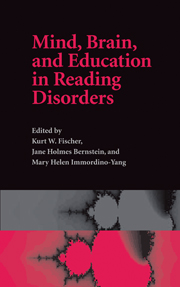Book contents
- Frontmatter
- Contents
- List of figures
- List of tables
- List of contributors
- Acknowledgements
- Part I What is Reading, and What are Reading Disorders? Looking to Neuroscience, Evolution, and Genetics
- Part II Reading and the Growing Brain: Methodology and History
- Part III Watching Children Read
- Part IV Reading Skills in the Long Term
- 15 The importance of comprehension in reading problems and instruction
- Essay: Bring reading research to the trenches
- 16 What successful adults with dyslexia teach educators about children
- 17 Is a synthesis possible? Making doubly sure in research and application
- Appendix: Transcript and behavioral data from Profiles in Reading Skills (Four Boys)
- Index
- References
16 - What successful adults with dyslexia teach educators about children
Published online by Cambridge University Press: 22 September 2009
- Frontmatter
- Contents
- List of figures
- List of tables
- List of contributors
- Acknowledgements
- Part I What is Reading, and What are Reading Disorders? Looking to Neuroscience, Evolution, and Genetics
- Part II Reading and the Growing Brain: Methodology and History
- Part III Watching Children Read
- Part IV Reading Skills in the Long Term
- 15 The importance of comprehension in reading problems and instruction
- Essay: Bring reading research to the trenches
- 16 What successful adults with dyslexia teach educators about children
- 17 Is a synthesis possible? Making doubly sure in research and application
- Appendix: Transcript and behavioral data from Profiles in Reading Skills (Four Boys)
- Index
- References
Summary
Overview: A major problem in teaching dyslexic children is their learned negativity toward reading, built from multiple frustrating and embarrassing encounters with printed text. Fink suggests going beyond goals that treat reading comprehension and fluency as if they are disembodied skills, and argues for the importance of the motivating forces of affect and interest. Reading, after all, is about the skill of getting information through text. Based on her in-depth study of successful adult dyslexics, Fink suggests several affective hooks to draw in reluctant dyslexic children, especially emphasizing their individual interests and passions and catering to them. This essay provides a reminder that in the end, one major purpose of studying dyslexia is to translate the research into effective strategies to help learning-disabled children become successful adults.
The EditorsThis essay analyzes development in 60 highly successful men and women with dyslexia and relates the boy William (Bernstein, this volume) to these adults' histories. The 60 men and women developed literacy three to four years later than normally developing peers (Fink, 1995/96, 1998a, 1998b, 2000a, 2000b; Mascolo, Li, Fink, & Fischer, 2002). They followed non-linear developmental pathways similar to a pathway found in children by Fischer and his colleagues (Fischer & Bidell, 1998; Fischer & Knight, 1990; Fischer, Rose, & Rose, this volume).
The men and women include professionals in a variety of fields that require sophisticated reading (i.e. law, medicine, business, and the arts and sciences).
- Type
- Chapter
- Information
- Mind, Brain, and Education in Reading Disorders , pp. 264 - 281Publisher: Cambridge University PressPrint publication year: 2007
References
- 3
- Cited by



